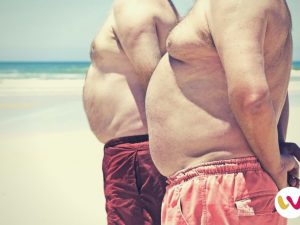Intermittent fasting (IF) seems to be an eating regime that has taken the health and fitness community by storm. However, with such a vast amount of information on the internet and such variation in fasting methods, learning about intermittent fasting can be difficult. Deciding whether to implement intermittent fasting into your life can be even harder.
Luckily, our guide can give you the information you need to learn about different intermittent fasting methods and whether or not this eating regime may be right for you.
What is Intermittent Fasting (IF)?
Intermittent fasting (IF) is adjusting your eating scheduling so that you only eat within an individually scheduled time frame. You eat during a window of time, and then you cannot eat outside of this window of time.
Intermittent fasters usually eat during the time in which they are allowed to eat, but they either severely restrict calories or fast (eat no food) outside the window of eating. This is where the notion of “fasting” comes from in this lifestyle.
Many intermittent fasters have used this method as a dieting technique to lose weight. However, intermittent fasting can be considered a more long-term lifestyle choice or trained eating habit.
Intermittent fasting attempts to curb hunger and improve the functions of your hormones. In doing so, it can enhance the body’s ability to burn fat and use energy. At the same time, it can reduce blood sugar, reduce inflammation, and improve heart health.
To read more about the benefits, check out “Effectiveness & Health Benefits” below.
Aside from the health benefits, Intermittent fasting is an excellent choice for some people trying to maintain or lose weight because it allows for great freedom of choice and it can help promote the consumption of whole or fresh foods.
It can reorient users toward fresh food because eating within a specific timeframe because it gives focus to what you eat because it is also essential when you eat it. Other fasters find that they can eat what they want.
Intermittent fasting can be challenging to start and maintain. In the beginning, fasters may feel ill or tired. However, these side effects often subside, and fasters begin to feel the benefits of fasting. Additionally, hunger can also be distracting as you start to implement this eating regime.
However, there are several different ways to implement intermittent fasting into your lifestyle. Read about the various methods of implementation and choose the method that best fits your lifestyle.

Intermittent Fasting Methods
There are several different versions or methods of intermittent fasting. Each has its benefits and downfalls. Here are just a few ways and how they work.
Regardless of the method, there will always be a fasting period, which is the time frame when you cannot eat. There is also always be a “feeding period,” which is the time when you are allowed to eat.
The 5:2 Fast
This method is usually listed as one of the first two methods of intermittent fasting that you can adopt. It is perhaps listed first or second because it is one of the more popular versions of intermittent fasting.
In this method of intermittent fasting, you eat significantly lower calories (around 500-600 calories) for two days of the week. These can be any two days of your choice. However, you eat as you usually would during the other five days of the week. Hence, this version is given the name 5:2.
This method has some of the same benefits as other methods. Many fasters like this method because you can eat during the “fasting period.” Rather than having a window of no food, there is just a window of significantly reduced food consumption. This is more appealing to most people, rather than having windows of absolutely no food.
The 16/8 Method or Time-Restricted Eating (TRE)
This method is also popular because it is easier to fit into most lifestyles. Compared to other methods, this one is both easier to adopt and maintain than other options.
In the 16/18 method, you choose an 8-hour window for eating. That means you cannot eat for the other 16 hours of the day. For most people, eating from 12 p.m. to 8 p.m. is reasonable. Then between 8 p.m. and 12 p.m. the following day you can only drink beverages with little no calories, like water, teas, and coffee.
This method may be easier to maintain and adapt because it can be tailored to fit your schedule. For most people, it is easier to skip breakfast and eat from noon until 8 p.m.
While you can set your feeding schedule, it is good to keep in mind that studies from Cellular Metabolism show more health benefits of fasting after 2:00 p.m.
This method is also sometimes referred to as time-restricted eating (TRE) because the feeding window can be adapted to 12 hours eating and 12 hours fasting. Typically, fasting should be between 12-20 hours.
Warrior Fast
The warrior fast is similar to time-restricted eating, except this method is more extreme. In this method, you only have a 4-hour feeding window. With this method, you can eat raw vegetables and fruits throughout your fasting period. Then, you typically eat one large meal at night.
This method is more attractive to those on a paleo diet because the foods are similar. It promotes raw and natural foods.
This also may be good for grazers. You can graze on fruits and vegetables during the day and finally have your big meal at night.
Eat-Stop-Eat Method
This method is just as it sounds. You eat a meal and then decide to fast for 24 hours. This fast can occur at any time. It is recommended to do this twice a week, but it can be done safely up to three times a week.
During the fast, you can only have no-to-low calorie beverages, but you cannot have food. Like the other methods, you can decide when to do this. You can do it when the mood strikes you, or you can plan it into your schedule for convenience.
This method may be hard to integrate into your schedule, especially if you are not consistent. Your body may feel exceptionally hungry by the end of the fast.
It may be ideal for building up to the entire 24-hour fast. You can try 12-14 hours on your first fast. Then you can try 16-18 hours on the following fast. This way, you begin to acclimate your body to the fast rather than shocking it by fasting suddenly.
Alternate-Day Fasting or Every Other Day Method
The title explains this method: you fast every other day. There may be variations in this, but the basic principle is to eat one day and fast then next.
In some variations, you may be able to graze on fruit and vegetables. You may also eat up to 500 calories on the fasting days in other versions.
This method and its variations can be difficult to acclimate to. This method is more intense and extreme than the other version, so it should be considered carefully. It is difficult to sustain long-term, simply because you will feel starving by the end of fasting days.
These are only just a few methods. It is a good idea to research each technique and their possible variations to choose the best intermittent fasting method for your lifestyle, your goals, and your body. As always, it is essential to talk to a medical professional before implanting any serious eating regime into your lifestyle.

Weight Loss & Intermittent Fasting
Intermittent fasting is often used as a method for weight loss or as a form of dieting. While it can result or aid in weight loss, it should be considered more of an eating lifestyle or habit rather than a crash diet.
The two most significant reasons that intermittent fasting contributes to weight loss are (1) consumption of fewer calories and (2) consumption of more nutrient-rich and nutrient-dense foods.
Frequently, intermittent fasters tend to skip a meal. For many, the meal maybe breakfast. While you still aim to consume the same amounts of food during feeding windows, skipping a meal often leads to the consumption of fewer calories. Less caloric intake leads to weight loss.
Perhaps the most significant contribution to weight loss during intermittent fasting is the consumption of healthier foods. Since there is a smaller window to eat food, fasters must make the most of the time in which they can eat. This means they need to get the nutrients they need within the time frame they are allowed to eat.
Eating within a specific time frame focuses you on eating more nutritious foods and fewer junk foods. You cannot get the nutrients you need outside of your feeding window, so you must maximize the nutrients and vitamins you receive during the feeding window
The combination of these two elements leads to weight loss is intermittent fasting. At the same time, the body is being trained to utilize the fat stores it has and to improve muscle growth or maintenance.
If it tries to improve eating habits and choices while trying to train the body to use its fat stores and improve metabolic rates, the combination further contributes to weight loss and healthier lifestyles.
The Harvard School of Public health shows research that demonstrates 40 studies suggesting that intermittent fasting is “effective for weight loss, with a typical loss of 7-11 pounds over ten weeks.” However, studies indicate that this weight loss drops after a year and becomes a way to maintain weight rather than lose it.
Whether trying to lose some weight or maintain it, intermittent fasting can be effective in helping you reach your weight goals.
Intermittent Fasting Side Effects
The side effects of intermittent fasting are similar to the side effects attributed to fasting in any scenario. There will be side effects to not feeding your body during the day.
For most, the side effects can be managed or overcome. Side effects can also vary between individuals. It is always ideal to talk to a professional about intermittent fasting before and after starting it.
Side effects can include:
- Hunger and Cravings
- Heartburn
- Addiction to caffeine
- Headaches
- Fogginess
- Lowered energy & fatigue
- Dehydration (if you forget to drink during fast periods)
- Mood swings
- dizziness
As can be seen, some of these side effects can be managed, but others may be harder to control. If your body has less readily available energy, then you may feel tired and fatigued more easily. Similarly, some individuals may experience a sudden drop in blood sugar levels. This can lead to dizziness, confusion, or fainting (passing out).
Understandably, some of these side effects are serious. Therefore, intermittent fasting should be done carefully in consultation with a medical doctor or healthcare provider.
Less severe effects are simply a result of being hungry. Some individuals became irritable, anxious, or angry when hungry. It is essential to know how your mood responds to hunger so that you do not interact negatively with others while you fast.
Effectiveness & Health Benefits
While some people may see this as just a means to lose weight, intermittent fasting has significant benefits for those who are also just looking to maintain their weight and improve their health.
The Ageing Research Review (2018) demonstrate benefits of intermittent fasting on overall health and “importantly, can counteract disease process and improve functional outcome in experimental models of w wide range of age-related disorders including diabetes, cardiovascular disease, cancers and neurological disorders such as Alzheimer’s disease …”
Intermittent fasting in subjects has shown improvement in weight loss for those who are overweight or obese.

Intermittent fasting improves insulin resistance because the scheduled fasting helps the body regulate blood sugar and glucose levels in the body. Some users with diabetes find that their blood sugar levels are more regulated and more manageable because of intermittent fasting.
Regulation of glucose and insulin resistance help improve heart health and enhances resistance to cardiovascular diseases.
While one initial side effect may be drowsiness and fatigue, studies by Psychiatry Research show that more long-term intermittent fasting can “include increased alertness/arousal and increased mental acuity.”
Some fasters even experience a better sense of calm and tranquility. Those with depressive moods or anxiety may feel fewer depressive symptoms. Some researchers attribute this to less anxiety and focus on food and more ability to focus on other tasks. At the same time, scientists suggest that neurobiological mechanisms in the brain may be triggered by fasting that help improve mood over time.
Regardless, intermittent fasting may improve mood, productivity, and alertness.
Studies have suggested that intermittent fasting can increase lifespan. One research has proven that intermittent fasting increased rats’ lifespans by 30-40% (Goodrick). Therefore, intermittent fasting has anti-aging properties on the body.
Here is just a shortlist of some of the reported health benefits of intermittent fasting (IF):
- reduction of levels of fat
- retention of lean mass
- increased lifespan
- reduced glucose and insulin levels
- better mobilization of fatty acids
- improved glucose tolerance
- improved glucose regulation
- reduced resting heart rate
- reduced blood pressure
- improved cardiovascular health
- improved heart health
- enhanced activity in the brain
- prevent and manage diabetes (shown more towards diabetes type 2)
- reduced inflammation in the body
- enhanced cellular stress resistance
- increased metabolic rates
- increased prevention against neurological disease (like Alzheimer’s, Parkinson’s, and Huntington’s disease)
- increased prevention against strokes
As can be seen, there are a significant number of health benefits to intermittent fasting. These range from benefits to brain activity and health to the prevention of serious diseases.
Significantly, intermittent fasting improves your cardiovascular health. Your heart may be better because of it. With so many benefits, it may be time to consider talking to your healthcare provider about intermittent fasting.
Give Intermittent Fasting a Try: Why You Should Do It
There are several reasons why you should try intermittent fasting. The most important reason is the health benefits. Look at the list of health benefits, and it is easy to be convinced to try intermittent fasting. Why wouldn’t you want to improve your cardiovascular health and prevent serious diseases in your future? The health benefits alone are convincing to give intermittent fasting a try.
Intermittent fasting can also be convenient. Since you get to choose your feeding window and fasting time, this eating lifestyle is more comfortable than other diets. You can choose whatever time fits into your schedule.
In most intermittent fasting methods, you can eat what you want, but fasters find out it is better to eat healthier options. Therefore, it is not only convenient, but it also guides you into making better food choices.
FAQs
Can I eat during the “fasting period” or “fasting window?”
The answer to this question depends on the intermittent fasting method you are following. For some methods, like the Warrior fast, you can nibble on raw fruits and veggies during your fasting time. However, some methods the Eat-Stop-Eat method truly depends on you not eating solid food during the fasting period.
If you find that you need to eat something because of dizziness or dropping blood sugars, it may be a good idea to have a small snack to hold you over until your eating period. Be sure not to indulge in too many snacks and make it a habit in your intermittent fasting regime.
Can I Drink During the Fast Periods?
Yes. It is best to stay hydrated during fasting times. You want to drink water. You can also drink non-caloric beverages or low-calorie drinks. These include coffee and tea. However, you want to try to limit your milk and cream to just a small amount.
Can I Take my Supplements While Fasting?
Yes! You can continue to take the most vitamins. You will want to make sure that your supplements do not need to be taken with meals. Some supplements rely on absorption with meals. These supplements will not work while you are intermittent fasting.
Can I Still Workout When Fasting?
Yes! You can! Working out can lead to the retention of lean muscle and reduce the loss of muscle.

Will I Lose Muscle?
While intermittent fasting may cause you to lose less muscle, all weight loss methods can cause muscle loss. You can prevent this with muscle-building workouts and eating protein.
Will Fasting Slow Down or Speed Up My Metabolism?
The Methods listed only suggest short-term fasting for one day or several hours because of short-term fasting boots the metabolism. Fasting for more than three days can slow down the metabolism, as it tries to conserve its energy and fat stores.
Therefore, the following methods where fasting is a day or less usually leads to a boosted metabolism.
What is the Best Time to Fast?
While you can set your fasting and feeding schedule, studies have shown that fasting after 2 p.m. provides the best health benefits to the body. Keep in mind that the benefits can still be achieved when fasting at other times.
The Bottom Line – Start Your Fast
There is so much information about intermittent fasting that it is difficult not to try it for yourself. You can choose a method we have listed above, or you can begin to research other variations that fit your body and lifestyle.
Always be sure to assess your needs and goals when choosing a method of intermittent fasting that suits you.
Making better food choices and having improved health while remaining convenient and within your control seems like the best kind of eating regiment. Perhaps it is time to give intermittent fasting a try.
References
Fond, G., et al. (2013). Fasting in mood disorders: neurobiology and effectiveness. A review of the literature. Psychiatry Research, 209(3): 253-8. https://www.ncbi.nlm.nih.gov/pubmed/23332541/
Goodrick, C.L,, et al. (1983). Differential effects of intermittent feeding and voluntary exercise on body weight and lifespan in adult rats. Journal of Gerontology, 38(1): 36-45.
Harvard School of Public Health. (2019). Diet Review: Intermittent Fasting for Weight Loss. Nutrition Source, https://www.hsph.harvard.edu/nutritionsource/healthy-weight/diet-reviews/intermittent-fasting/
Mattson, M.P, et al. (2018). Impact of intermittent fasting on health and disease processes. Ageing Research Review, 39: 46-58. https://www.ncbi.nlm.nih.gov/pmc/articles/PMC5411330/
Sutton, EF, et al. (2018). Early Time-Restricted Feeding Improves Insulin Sensitivity, Blood Pressure, and Oxidative Stress Even without Weight Loss in Men with Prediabetes. Cellular Metabolism, 27(6): 1212-1221. https://www.ncbi.nlm.nih.gov/pubmed/29754952









Add Comment